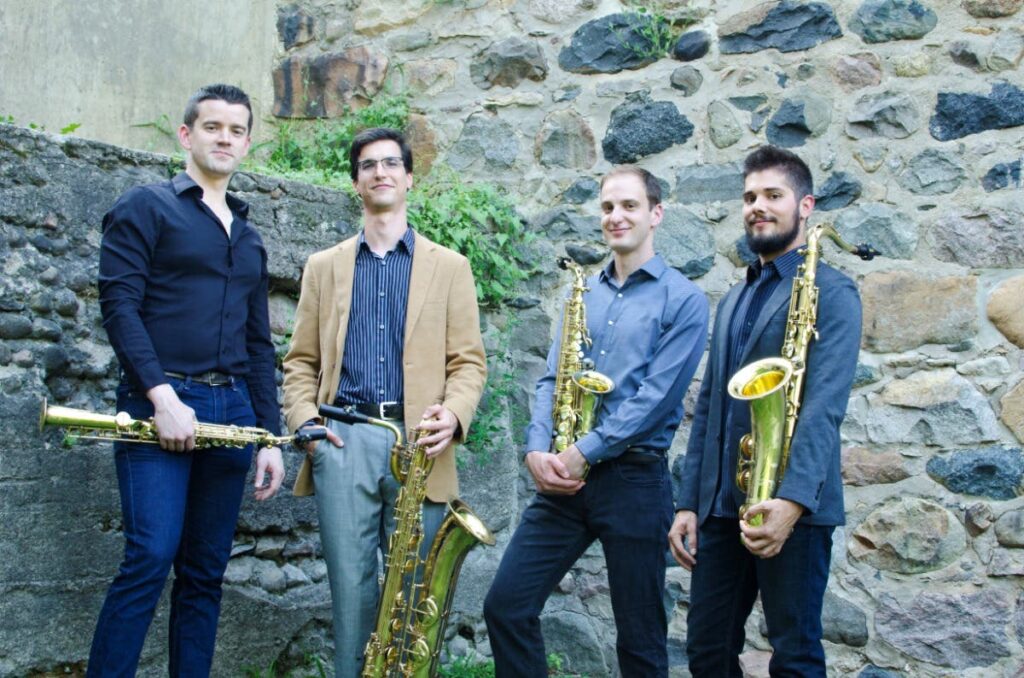Sinta Quartet brings flair to classical and folk music in Coral Gables
The saxophone has long been a major instrumental component of jazz and pop ensembles. Some classical composers, especially Ravel and Prokofiev, have utilized the instrument to striking effect. A chamber group of saxophone players, however, is an audacious project.
On Thursday night, the Community Arts Program of the Coral Gables Congregational United Church of Christ presented the Sinta Quartet as part of its summer concert series. Comprised of four players who were students of distinguished sax artist Donald Sinta at the University of Michigan, the group presented a concert that mixed transcriptions of classical works with contemporary creations plus some traditional dances.
The musicians threw down the gauntlet by opening with their arrangement of Dvořák’s String Quartet No. 12 in F Major (“American”). As Dan Graser—the quartet’s soprano saxophonist and dominant personality—told the audience, this version does not change a note of Dvořák’s original creation. One admired the dedication and ambition of these versatile musicians in attempting to find equivalents to violin, viola and cello parts by giving those voices to soprano, alto, tenor and baritone saxophones.
Yet in the outer movements, that formula did not really work. The soprano sax, playing the line usually assayed by a quartet’s first violin, sounded piercing to the ear much of the time. The tempo the players adopted for the opening movement was faster than most string quartets would dare, and the finale sounded too much like a big-band romp. In its unique way, this iteration proved entertaining, but it was far from the pastoral Americana of Dvořák’s original, mostly created during a summer idyll in Spillville, Iowa in 1893.
This arrangement worked best in the middle movements with the Native American-infused main theme of the Lento taking on a poignant character when played by Graser on soprano sax. The Vivace emerged as an evocation of birdsong well suited to the instruments. The two lower voices (splendidly rendered by Joe Girard, tenor sax and Danny Hawthorne-Foss, baritone sax) came closest to the tones of their string counterparts. Graser, Girard, Hawthorne-Foss and Zach Stern (on alto sax) are all masters of their instruments, and played the entire work from memory.
While György Ligeti (1923-2006) is noted for being a leading light of the Eastern European avant-garde, many of his early works are strongly influenced by Hungarian and Romanian folk music. His Six Bagatelles for Wind Quintet, conceived in 1953 as transcriptions from a set of piano vignettes, mixes some of the composer’s trademark dissonance with indigenous melodic paths.
The effect is like a score for a horror movie set among the peaceful rural fields of Hungary. That is particularly true of the fifth section “Mesto – Bela Bartók in memoriam” in which Hawthorne-Foss’s baritone instrument emerged with the aural spectre of a bassoon in its most eerie mode. The crunchy discords of the final Vivace- Capriccioso exploited the highest and lowest extremes of the instruments.
The program’s first half concluded with Graser’s arrangement of Csürdöngölö by Hungarian composer Leó Weiner. A high- spirited country dance almost like a klezmer hora, the tune proved irresistible, especially when played with the foursome’s bravado.
The program’s post-intermission segment was devoted to folk music and works strongly inspired by melodies from rural America and Ireland. To state that these pieces seemed a better fit for the mixed saxophone combination in no way diminishes the players’ outstanding musicianship.
Ashokan Farewell by Jay Ungar is one of those haunting tunes that remains in the mind’s ear long after sound and lights have been extinguished. (The tune was utilized by documentary filmmaker Ken Burns in his Civil War series.) Graser’s clever transcription began with solos by the highest instruments, then passed to the lowest and back again.
UFO Tofu by banjo virtuoso Béla Fleck combines jazz and bluegrass in a palindrome form and brought forth the full spectrum of the players’ technical aplomb. The sentimentality of Appalachia Waltz by self-proclaimed fiddler (as opposed to violinist) Mark O’Connor, however, is not the same without strings.
The musicians seemed to be having fun with a traditional reel set. In Graser’s transcription, O’Connor’s “Emily’s Reel” suggested Scottish dances and Americana blended with the Irish side. Their rapid-fire articulation of “Mason’s Apron” (a tribute to mandolinist and father of bluegrass Bill Monroe) was faster than most mandolins or string bands could attempt. The concluding medley of traditional Irish dances “The Green Groves of Erin” and “The Flowers of Red Hill” suggested Scottish bagpipes and displayed Girard and Hawthorne-Foss’s dexterity in a high stepping finale.
Posted in Performances
Leave a Comment
Fri Aug 4, 2023
at 11:15 am
No Comments
